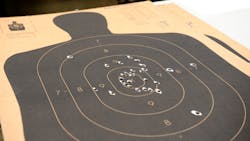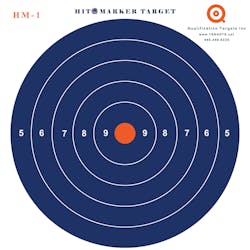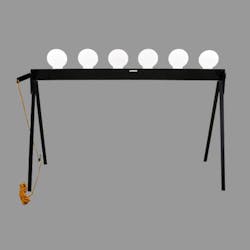If you walk into any gun shop in America today you’ll find several dozen different types of paper targets available along with steel targets galore. Among the designs on paper will be everything from the standard B-27 black silhouette to zombies, overlarge spiders, creepy clowns, and more. The steel targets you find will include everything from a single falling target (pepper popper) to plate racks to dueling trees to single 8”x 12” steel targets. With such a variety of targets available, not to mention all of the virtual systems and improvised targets, how do you know what’s best to use and when?
The proper selection and use of a given target should depend on the skill objective being trained. If a shooter is relatively new or simply wants to focus on basic marksmanship, a paper bull’s-eye or standard silhouette target will suffice. If the shooter is sufficiently skilled and simply wants to add some entertainment to the shooting practice, any of the zombie/creepy clown/huge spider target assortments can be used. They usually still have scoring markings on them and make the training day more interesting than shooting plain paper.
Another measure of performance can be added with paper targets by using snap-caps or dummy rounds to create artificial malfunctions. Under stress and tight time limits, a shooter can be challenged by having to shoot a course, clearing the artificial malfunctions as they go. Most veteran firearms instructors will tell you that just this simple adjustment to the course can negatively impact the overall scores.
When you have a group of shooters who are competent and have reasonably decent marksmanship skills, adding reactionary targets increases training options and can add a level of enjoyment. For instance, falling plates, either on a rack or stand-alone, both make a sound and fall when hit. Falling targets can be set to require two hits before they fall; that’s two consecutive hits within a limited time or they “reset” and the first hit did no good overall.
Plate racks, falling singles and dueling trees can add fun via competition as well. Remembering that the goal of firearms training is to have shooters who can hit a target with skills they have mastered and without the extended time of concentrated thought, putting two of them side by side and having them shoot a “duel” adds a competitive flavor to the training. If you have a six-plate dueling tree—a steel “tree” that has six plates that will swing from left to right or right to left when hit— you can set it up with three plates on each side. One shooter is on the left and one shooter is on the right. The goal, within the given time or ammo limit, is to have all the plates on the other guy’s side. To accomplish this, one shooter has to shoot accurately and just slightly faster than the other. Such competition puts an emphasis, however subconsciously, on the application of basic marksmanship. It’s training with the only score being who won, this time.
The single steel plates that don’t fall but can be placed on stands or hung from mounts are good for longer distance engagements where holes in paper targets can’t be seen. For instance, from 25 yards or more, seeing a 9mm hole in a black paper target is near impossible depending on the lighting. But if you hang or place a 12”x 18” plate instead, then every hit or miss is obvious. A shooting instructor or coach who counts the hits out of a given number of shots can produce a score for the string and, depending on the backstop, may be able to give the shooter an indication of where they missed: high, low, left, or right.
Other reactionary targets can be used such as balloons or falling targets. Several commercial companies make targets that fall when a bullet hits and passes through them. Some of those systems can be reset by electronic controls or by pulling a rope or other functions. One benefit of teaching officers to shoot until a target falls is that it conditions the mind away from the “magic bullet” concept. If you believe Hollywood, a single bullet will stop any bad guy and quite often lift him off his feet, propelling him ten feet through a window or over the hood of a car. That’s just not how physics works. We’re better off teaching officers to shoot until a threat has been neutralized, evaluating the need for follow on shots after each shot is fired.
Where range space may not be available or is limited, virtual shooting simulators play a great role in developing not only basic marksmanship skills but also judgmental skills. With a proper setup and skilled instructor, each shooting simulation can challenge the shooter’s ability to observe and process applicable data, shoot as necessary, and while taking cover and giving verbal commands. Some “shoot back” systems will penalize the shooter with a stinging rubber ball/pellet if they fail to move to cover. In these simulations, a shooter’s judgment can be tested, evaluated, and documented, usually on paper and in video, for departmental purposes.
The ultimate goal of any training program is to produce an officer that can shoot accurately, under duress, in compressed time limits, but within all applicable federal, state, county, and city laws as appropriate. Further, the shooter must be able to articulate why he chose to fire the shots and why he chose to stop shooting. Developing that level of competency simply can’t be done using only a paper target.
About the Author
Lt. Frank Borelli (ret), Editorial Director
Editorial Director
Lt. Frank Borelli is the Editorial Director for the Officer Media Group. Frank brings 20+ years of writing and editing experience in addition to 40 years of law enforcement operations, administration and training experience to the team.
Frank has had numerous books published which are available on Amazon.com, BarnesAndNoble.com, and other major retail outlets.
If you have any comments or questions, you can contact him via email at [email protected].



